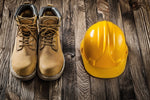
How Should Work Boots Fit? A Guide
, by Ed Stone, 5 min reading time

, by Ed Stone, 5 min reading time
Tough jobs call for even tougher footwear with the benefits of work boots exceeding just comfort and wearability. And when you’re performing manual labor, like heavy lifting, plumbing, or electrical work for ten to twelve-hour days, you need a work boot that can keep up with your stamina.
To start, your steel toe work boots need to focus on two elements: safety and fit. And while ensuring your work boots have all the necessary hazard compliance features like safety toes and water resistance is important, if the steel toe boot doesn’t fit, well, that’s a non-starter.
So, how should a work boot fit?
Overall, the safety boot should feel snug but not tight and secure but not restrictive. It’s a tricky balance, to be sure, so let’s dive into the specifics.
Picking out a work boot that looks good, meets safety requirements, and keeps your feet pain-free requires a little more nuance than just matching up to a size chart. With more than a hundred muscles, tendons, and ligaments alongside a slew of bones and joints, your feet are a complex part of your body that will benefit from the right supportive safety boot.1
When your shoes or boots fit incorrectly, it can lead to a pitfall of problems down the road that stretches beyond just your feet. Improper fit where your foot doesn’t rest in a supported, neutral position could cause issues such as plantar fasciitis, arch collapse, body misalignment, leg and back pain, and more.
When you find a work boot with a look you love, there are a few things you should check during try-on to ensure the right fit. Once you confirm the fit is right for you, then you can get to the fun stuff and learn how to break in your work boots. Here are a few key components to check when trying on a new pair of work boots:
Your heel should fit comfortably in the safety shoe with a little room for movement. Having a good fit around your heel means keeping it supported and protected. A quality work boot will have a structure to cradle the heel and cushion for shock absorption as you walk and move around throughout the workday.
Your midfoot area should have comfortable arch support. Ideally, you want just the right amount of lift to avoid overpronation or rolling in. Keeping your foot supported in its neutral position will help deter arch pain and other foot and body issues that can arise. Look for arch supports that hold their shape rather than sink and collapse under pressure.
The ball of your foot should be positioned in the widest part of the footbed. It needs to rest naturally, with no scrunching or tightness, allowing the toe joints to bend when you move around. Again, think snug and secure but not tight or restrictive. You’ll want room for your foot to bend when you walk but not so much space that your foot is swimming inside the shoe.
Toes need a little wiggle room in your work boots. Never cram them in or have them scrunched and crinkled. There should be about an inch between your toes and the edge of the toe box. Give them room to move and groove without touching the front or sides of the toe box so they have enough space to move freely as you take your boots through the paces.
How tight should work boots be? Ideally, you want them to feel snug and supportive. Avoid pinching, pain, and pressure—if they’re uncomfortable; you might need to adjust the size up.
Alternatively, a loose steel toe boot can cause its own set of issues. Avoid letting your foot slip and slide around inside a boot that’s too large.
A well-made boot crafted with high-quality materials is more likely to meet or exceed the criteria for a comfortable and supportive fit. Trusted brands with a focus on functional workwear, like CAT work boots, are made to last and designed to offer protection against occupational hazards. They may also offer additional features to make your workday easier, like water resistance, breathable linings, shock absorption and stability support.
Whether you prefer composite toe vs steel toe boots, if your favorite work boots need a little nudge to be just right, try these tips and tricks to get a better fit:
With over fifty years of knowledge specializing in occupational and work boots, Boot World will help you select the perfect boot to support and protect your feet, whether you’re at work or play.
Our customized Boot World Sizing Scale provides detailed sizing recommendations for each boot model, including relative length and width, to help you get the right fit the first time. Browse our large selection of women’s and men’s lightweight boots and find a pair that will hold up to even the toughest of jobs while keeping your feet comfortable and secure.